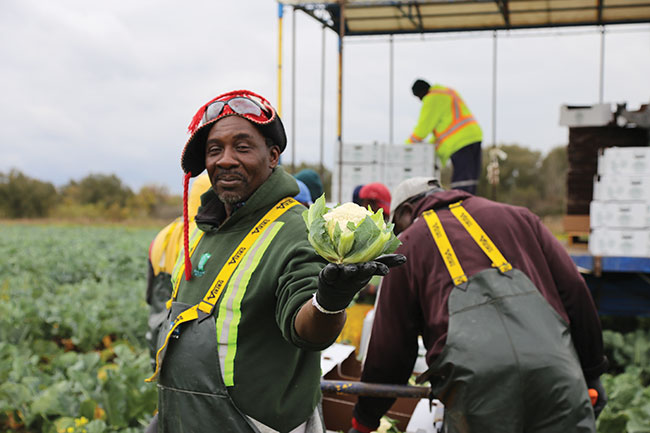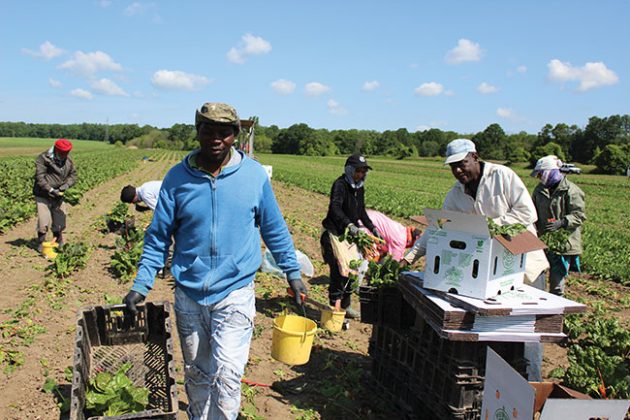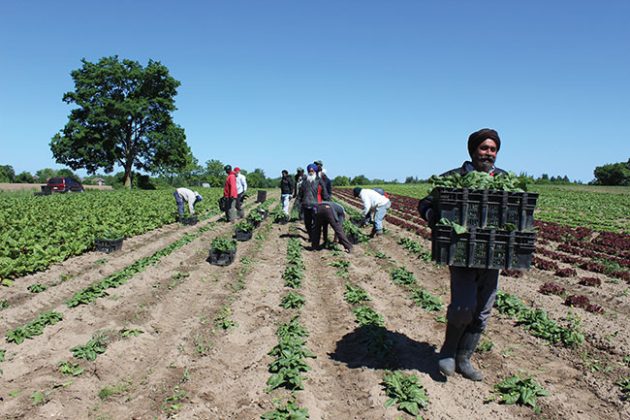
Features
Labour
Organic Perspective
Food waste within the supply chain
March 28, 2022 By Samantha Mills
 A worker at Pfenning’s Organic Farm in Hamburg, Ont., shows off a recently harvested cauliflower in the field. Photos courtesy of Pfenning’s Organic Farm.
A worker at Pfenning’s Organic Farm in Hamburg, Ont., shows off a recently harvested cauliflower in the field. Photos courtesy of Pfenning’s Organic Farm. The Canadian government classifies food that is grown, raised, harvested or caught but never eaten as food waste. In 2019, the CBC reported that roughly 58 per cent of food produced in Canada becomes food waste. In worst-case scenarios this food ends up in landfills, where it is left to decompose and release greenhouse gases such as methane. Reducing food waste has clear economic, humanitarian and environmental benefits.
The 2022 Guelph Organic Conference (GOC), co-organized by the Organic Council of Ontario, focused on the climate-related benefits of organic agriculture. In a session about reducing food waste in agricultural production systems, farmer Wolfgang Pfenning of Pfenning’s Organic Farm shared his insights on the factors contributing to food waste at each step of his production line. The Pfenning family have been farming in New Hamburg since 1981 and current operations are run by Wolfgang and Ekkehard; their products can be found in grocery stores around Ontario. The following is a synopsis of Wolfgang’s GOC presentation.
Field
Some crops do not even make it off the field due to unpredictable weather and the struggles associated with timing staff numbers with the harvest. This type of loss is less costly than other forms of food waste since it involves the fewest resources. There is little that can be done to reduce food waste at this point, but investing in better harvesting equipment can help reduce crop damage. Farmers can also pre-sell crops before harvest and understand customer trends to ensure that harvested crops will sell. Pfenning’s keeps careful track of annual vegetable sales and plants accordingly the following year.
Post-harvest
Crops can still be damaged after harvest. Pfenning explained that, for every hour harvested food sits with a high internal temperature, a day of shelf life is lost, so crops must have their internal temperature lowered immediately after harvest.
Another source of post-harvest food waste is the food grading process. To reduce this type of waste, products that fail to meet specifications can still be sold as other products. Pfenning’s repurposes any substandard organic carrots as animal feed or brings them home to eat, but a certain number of substandard products may still become compost.
Best practices to reduce food waste should include measures to improve shelf-life. Pre-cooling techniques like room cooling, hydrocooling, vacuum cooling, forced-air cooling and contact icing are considered the most cost-effective methods for obtaining market-quality products. Fruits and vegetables should have limited exposure to ethylene, the plant hormone that causes ripening. Keeping crops cooled and well-ventilated prevents ethylene buildup. Ethylene-sensitive crops should be separated from any potential sources of this hormone.

Crop loss in the field is less costly than other forms of food waste since it involves the fewest resources.
Distribution
For foods with a short shelf life, mistiming distribution can result in food waste. Delayed or overlapping shipments mean stores can end up with too much or too little food to meet customer demand.
Keeping networks of communication open to optimize distribution will help reduce potential waste. It is also recommended to explore more local retail options to minimize the likelihood of food loss during transportation.
Retail
This is the supply-chain stage where the most rotting occurs due to improperly refrigerated display cases and labour shortages in customer service positions. Picky customers and cosmetic standards are also a source of food waste at this stage, as North American customers are likely to avoid food that is cosmetically imperfect or “ugly” but otherwise good to eat. Retailers may wrap up this “ugly” food and sell it for half-price, but this kind of food waste remains a problem. To reduce this problem, consumers could be educated to appreciate and enjoy “ugly” food.

Some crops don’t even make it out of the field due to weather and difficulties timing staff numbers with harvest.
Household
At this level, food waste occurs in the form of consumer habits. Overbuying, ineffectively preparing and storing food and throwing away leftovers are major waste sources. This is also the most costly form of food waste, since the food made its way through the entire supply chain, expending resources along the way. It would be beneficial to invest in consumer education to show the public how to shop, store, prepare and eat in a way that minimizes waste.
While some food waste is inevitable, there are still many ways in which we can avoid losses and distribute food more effectively. On a global scale, we are currently producing enough food to feed 10 billion people, far above our current population – although 811 million people still go hungry. We do not have a resource issue – we have a food waste issue. We can all help to reduce food waste and ensure our food supply is better distributed.
Check out OCO’s Organic Climate Solutions campaign, funded in part by the Government of Canada, to learn more about how farmers can reduce the environmental impact of agriculture and be part of the climate solution.
The Organic Council of Ontario (OCO) represents more than 1,400 certified organic operators, as well as the businesses, organizations, and individuals that bring food from farm to plate. OCO works to catalyze sector growth, support research, improve training, increase data collection, encourage market development, protect the integrity of organic claims, and inform the public of the benefits and requirements of organic agriculture. For more information, visit www.organiccouncil.ca.
Print this page